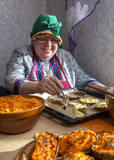| Нo | Название | Описание |
|---|---|---|
|
Atrodas Rīgas ielā 8 – skaistā, 1883. g. celtā jūgendstila ēkā . Muzejs (viens no Latgales lielākajiem un vecākajiem) tajā darbojas no 1959. g. (pats muzejs dibināts 1938. g.) un tā krājums vēsta par Daugavpils un tās apkārtnes vēsturiskajiem notikumiem. Tajā regulāri tiek rīkotas arī tematiskās izstādes, piedāvātas muzejpedagoģiskas programmas. Te vēl var apskatīt Daugavpilī dzimušā un pasaulē pazīstamā mākslinieka Marka Rotko (1903. – 1970.) gleznu reprodukcijas, kuras no 2013. gada plānots pārcelt uz M. Rotko centru Daugavpils cietoksnī. |
||
|
Из выросших на красивейшей возвышенности Вырумаа ягод и фруктов хозяева готовят вино, знакомят со своим садом и процессом приготовления вина, организуют дегустацию и курсы. |
||
|
В период с 1883 – 1891 гг. бывшую господскую усадьбу рода Шадурских арендовал отец Райниса Кришьянис Плиекшанс. Молодой поэт Райнис провел здесь молодые годы, что отражено в «земле молодых дней» поэта. В «Ясмуйже» переведена драма A. Пушкина «Борис Годунов». За вклад поэта в 1964 году в доме управляющего господской усадьбой создана экспозиция «Гимназические и студенческие годы Райниса». В восстановленном хлеве господской усадьбы выставлены работы гончаров Латгалии. «Ясмуйжу» стоит посетить в Дни поэзии или во время открытия печи (в июне и августе). |
||
|
Примерно 6-километровый и однообразный участок дороги между Рагациемсом и Клапкалнциемсом, где, если верить преданиям, в давние времена на путников нападали грабители. В дюне, примерно за 1,5 км до Клапкалнциемса (со стороны Рагациемса) в сторону моря установлен памятный камень в часть борьбы финских егерей. Открытие камня состоялось 9 декабря 1997 года. Камень прибыл из юго-восточной части Финляндии, где в 1940 г. служил противотанковым укреплением. На памятнике высечен текст: «Здесь во время Первой мировой войны, с августа по декабрь 1916 года боролись финские егеря». В свою очередь, в Клапкалнциемсе установлен памятный камень, где захоронены пять финских солдат. |
||
|
Расположена между озерами Банужи и Илзес. Считаетсяобразцом неповторимого деревянного строительства. Построена в 1780 г. Церковь возведена в технике строительства сруба и вплоть до начала 20 в. имеласоломенную крышу, которуюзаменили деревянной гонтовой крышей. |
||
|
Atrodas Rīgas – Daugavpils autoceļa (A 6) 118. kilometrā. |
||
|
The territory is established in order to protect the dunes and the seashore habitats. There are beautiful beaches and wooded dunes, and the paved Klaipēda–Palanga bikeway trails through the park, which is worth travelling at full length. |
||
|
The Kassari Island is the fifth largest Estonian island, and it is found to the South of the Hiiumaa Island. There are two dams between the two islands, and a road for motor vehicles has been installed atop them.
|
||
|
Деревенский дом, в котором вас встретит настоящая латышская хозяйка Скайдрите Наглиня и продемонстрирует традиции выпекания хлеба по унаследованному от предков рецепту. |
||
|
This is certainly the thickest White Willow (Salix alba) in Latvia and perhaps the thickest one in the Baltic States. Many of its mighty branches are resting on the ground, and the enormous monolithic trunk has been split. There’s a small information stand alongside the tree. A pathway which starts at the Raganu cliffs can be taken to the tree.
|
||
|
Varakļānu centrā, Rīgas ielas malā paceļas neliels paugurs, uz kura atrodas balta ēka ar 4 kolonnām un kupolveida jumtu, kas celta pēc Romas Panteona parauga. Kapela būvēta 1814. g. (arhitekts Vinčento Macoti), un tajā atrodas grāfu Borhu dzimtas apbedījumi. Kapelā bija novietoti arī Sv. Viktora pīšļi, kas pārvesti uz Varakļānu katoļu draudzes baznīcu. |
||
|
Ap 7 km garš lokveida pārgājienu maršruts (marķēts), kas ved pa dažādiem biotopiem – mežiem, mitrājiem un pļavām, mezdams līkumus pa stāvo pauguru nogāzēm. Takas malās ir izvietoti informācijas stendi un norādes. Rebases ainavu taka ir domāta tiem, kurus nebaida garāka iešana un orientēšanās pa ļoti dabisku un mazapdzīvotu apvidu. |
||
|
Этот маршрут включает в себя лучшие пешие тропы и достопримечательности в Национальном парке Гауя. Походы организованы таким образом, что путешественники постоянно находятся в движении. Главная «артерия» парка — это старинная долина реки Гауя с множественными притоками, и глубокие ущелья с массивными обрывами из песчаника времен девонского периода. Поход начинается от одной из самых старинных церквей в Латвии и идет вдоль реки, заканчиваясь у бобслейной трассы в Сигулде. На следующем этапе путешествия вас ждут живописные виды на реку, обрывы и природные тропы. Водный путь реки Амата вьется через девственные леса, и здесь же находится икона латвийского пейзажа — скала Зварте. В Цесисе откройте для себя маленькие улочки, взберитесь на башню церкви Св. Иоанна и посетите руины средневекового замка, прежде чем отправиться по природной тропе Цирулиши для исследования геологической истории края. Поместье Унгурмуйжа — единственное уцелевшее в странах Балтии деревянное поместье в стиле барокко. Короткая тропа вьется между вековыми дубами. В парке находятся также несколько важных культурных достопримечательностей: музей-резерват Турайда, поместье Кримулда и исторический центр Лигатне. |
||
|
"Ziedlejas" offers sauna treatments and events in the contemporary design Glass Sauna, Smīma Spruce Smoke Sauna and Black Sauna, which is located in an unspoilt corner of the forest. The ritual sauna treatment includes heating, herbal compresses, herbal scrub, big beating, swimming in the pond, massage with healing oil and honey, vibrating with sound, tea, home-baked bread. The sauna treatment lasts four to five hours and is led by a sauna master. Various master classes are possible in connection with sauna rituals and the use of plants in healing and beauty care and the preparation of appropriate preparations. Bicycle rental is available, which includes access to the Ziedleju xc / enduro trails, bicycle training and bicycle guide services. It is also possible to organize and lead team building events, as well as team communication trainings. |
||
|
”Cīruļi” atrodas 5 km attālumā no Rūjienas, Jeru pagastā. Īpašums ir pārmantots no paaudzes paaudzē, īpašniekiem vienojoties kopīgā mīlestībā uz ziediem, dažādu augu audzēšanai pārvēršoties arī par vaļasprieku. Dārzā atrodamas arisēmas, ramondas, magnolijas, knifofijas, rodžersijas, ligularijas, rožainā radiola, ehinācijas un vēl daudz vairāk pazīstamu, skaistu augu. Pavasaris iesākas ar sniegarožu un daudzo sīpolpuķu plaukšanu, vēlāk - krāsainie īrisu ziedi un trauslās astilbju skaras. Daudz skaistuma un krāsainības puķu dobēm piedod heihēras un hostas, kas priecē līdz pat vēlam rudenim. Dārzā aug arī skujeņi, vīteņaugi un katru gadu ražojoši vīnogulāji, kas veido pašu dārza telpu.
|
||
|
Находится на Пулеметной горке, которая является одной из самых высоких точек Длинной дюны. Рядом находится памятник доблестным латышским стрелкам, которые потерпели большие потери в ходе Рождественских боев в конце 1916 г. Просматриваются большие лесные массивы до самой Юрмалы и болото Мазтиреля, на котором хорошо выделяется место бывшей узкоколейной железнодорожной насыпи. Входит в Мемориальный парк Рождественских боев, где можно осмотреть музей Мангали, восстановленный “Немецкий вал”, памятники и другие объекты. |
||
|
The Līgatne Paper Factory is located at Pilsoņu Street 1 in Līgatne. The factory was first built in place of an old paper windmill by two tradesman from Rīga who also built dormitories for residents. These structures are an important component in the urban environment of Līgatne. The rapid flow of the Līgatne River allowed the factory to produce writing paper, stationary and wrapping paper. In 1858, the factory was brought by a local nobleman who brought in new equipment from Scotland. If some 100 people worked at the factory during the first half of the 19th century, then that number rose to 600 by the end of the century and 800 at the beginning of the 20th century. Writing paper was the primary product from the factory, although there were sometimes special orders. During World War I, for instance, the factory produced paper on which the Russian military printed its maps. This allowed the factory to hold an important role in the Russian market. During the Soviet era, the factory at Līgatne produced notebooks and other products that were sent all over the USSR. Today the factory mostly produces wrapping paper of various kinds from waste paper. The Līgatne Paper Factory is the only functioning entity of its kind in Latvia, and there are guides available to give you a tour. The historical centre of the campus on which the factory sits is a cultural monument. The Līgatne Tourism Information Centre (_371-6415-3313) offers tours of the centre during which you will learn about the lives of the factory's workers and administrators in the late 19th and early 20th century. Back then there was major construction work at the factory to build residences for workers, a school, a childbirth facility, a hospital, a club, a guesthouse and other buildings which have survived to the present day. |
||
|
Atrodas Rendā, pie tilta pār Abavu. Mazs, jauks krodziņš, kas atrodas vēsturiskā ēkā ar patīkamu interjeru. Piemērota maltītes ieturēšanas vieta ne tikai tiem, kas pārvietojas pa ceļu, bet arī Abavas laivotājiem. Strādā g.k. vasaras sezonā. |
||
|
Летний дом и баня с каминным залом на берегу озера Сила. Баня – каминный зал, баня, душ, 2-местная спальня. Летний дом – одна комната с двумя отдельными кроватями, сухой туалет.
|
||
|
Старинный ливский поселок, ливское название которого Mustanumm. Еще в середине 20-го века здесь жили ливы. В поселке Мелнсилс у впадения речки Бакупите в Рижский залив представители семейств Ландманисов, Морицов и Отомеров построили три парусника. В поселке находятся два культурно-исторических места: церковная гора Бакю – древнее культовое место и городище пирата Троммеля. (Источник: Ройский ТИЦ) |
||




















